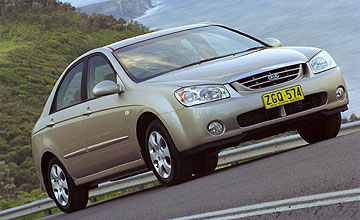BY BRUCE NEWTON | 2nd Jul 2004

There are highs and lows of course, the former being the engine and the latter the chassis, but overall Cerato barely rates a blip above or below flatline.
That’s disappointing but not unexpected. Cerato is designed to be a functional tool, rather than a fun device and in that it delivers. If you require urban transportation then you should consider.
In that chore the Cerato is particularly aided by a non-descript but pleasant cabin that offers plenty of space for adults front and rear in terms of leg and headroom, ample storage space including massive door pockets and comfortable seating.
There’s plenty of plastic and a pretty utilitarian looking radio, but there are nice touches too like the light/dark colour scheme, aerated door trim and air-conditioning vents at the top of the bulbous centre console that have neatly designed fully-closing vents.
It also appears that interior build quality is on the improve, although the dash and console could do with a few less switch blanks, which always look cheap to us.
And you’ll never have to wonder what speed you’re doing as the LARGE speedo dominates the simple instrument display.
The car is further aided in its urban endeavours by that strong engine, which offers plenty of acceleration effort without becoming too noisy. In class, it is strong enough to rank among the best.
The engine is best when mated to the auto because it makes life that much easier, not the least because it is intelligent enough not to rush around the cogs constantly as many autos do when mated to a small capacity powerplants.
The manual frees up a little more power and flexibility, but the shift is rubbery and the clutch take-up late and narrow, which takes some getting used to. That would also get tiring around town.
So far, not too bad. Unfortunately the ride and handling don’t perform up to an modern standards in-class set by Corolla, Astra and even the Pulsar. The under-damped suspension makes progress lumpy, unrefined and at time downright uncomfortable, on anything but billiard table-smooth surfaces.
We are not talking about medium and high-speed ride deterioration either. At low speed the car click-clacks over highway dividers and cat’s eyes, a noise produced by a combination of tyre and suspension.
Funnily enough that’s the greatest blight in terms of noise, vibration and harshness, which otherwise seems pretty well under control.
As speeds do rise there’s a sogginess that becomes apparent in the suspension set-up. The car simply cannot settle on typically undulating and pock marked Australian tar and you end up bouncing from one imperfection to another.
Allied to this, the body rolls too much when cornering, even when proceeding at a relatively cautious speed. And that’s to be recommended because the lack of steering feel and its vagueness means you’re never quite sure what the front wheels are doing (although understeering is a fair guess).
The brakes add to the question marks, tending to lack initial bite and then to come on too sharp. The uncertainty highlights and throws further question marks over Kia’s decision to exclude ABS.
For all the criticism there’s no doubt Cerato is an improvement over the old Spectra in all facets, but unfortunately that is not saying a lot.
Rather than demonstrating Kia has increased its command of automotive design, the Cerato shows clearly there is still a way to go for the company to break out of its comfort zone.
Fellow Korean Daewoo is making larger strides more quickly, while Malaysia’s Proton has caught up and passed Kia if the forthcoming Gen.2 is any indication.
In the end the Cerato is very much a car that pleases the hip pocket rather than the seat of the pants.